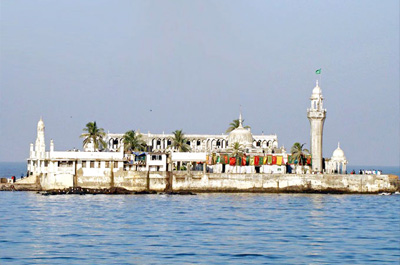Haji Ali Mosque

Honoring the Muslim saint Haji Ali this mosque was built in the middle of the sea with only a narrow path leading to it giving it an ethereal look. As per the Muslim traditions separate praying rooms for ladies and gents are provided here to pay their respects. It is set 500 yards into the sea and can be reached only in low tide. The Haji Ali mausoleum has an offshore location, opposite the Mahalakshmi racecourse. During high tide, the connecting causeway is submerged in water giving the impression that the mosque and tomb are floating out at sea in splendid isolation. This is The Haji Ali Dargah, the floating tomb of a wealthy Mohammedan merchant who renounced his worldly ways before embarking on a pilgrimage to Mecca.
The structure is a slim solitary minaret. It is linked to the mainland by a tenuous causeway, which is practically nonnegotiable during rough monsoon, tides. Behind the sculpted entrance, a marble courtyard contains the central shrine. Hundreds of worshippers stoop to press their forehead against the richly brocaded red and green chaddar covering the tomb, lying in an exquisite silver frame supported by marble pillars and is decorated with artful mirror work: blue, green, yellow chips of glass arranged in kaleidoscopic patterns interspersed with Arabic patterns which spell the ninety-nine names of Allah. Women sit behind carved partitions, their heads bent over the Koran. Every year, the tomb is washed with rose water, which is then distributed among the ailing for its healing properties and the faithful continue to tie red threads on wooden lattices to honor the soul of Haji Ali. It is a handsome example of Indian Islamic architecture, associated with legends about doomed lovers; the dargah contains the tomb of Haji Ali.
The legend goes that Haji Ali died on a pilgrimage to Mecca and miraculously his casket floated back to these shores. The mosque is picturesque with a vast courtyard and refreshment stalls. It contains the tomb of the Muslim saint Haji Ali. The saint is believed to have been a wealthy local businessman who renounced the material world and meditated on a nearby headland following a pilgrimage to Mecca. His devotees built the mosque and the tomb in the early 19th century. Alternate version says that Haji Ali died while on his pilgrimage to Mecca and his casket surprisingly floated back to Mumbai
The mosque can be reached only during low tide. The whitewashed mosque also has a cool courtyard generally full of people and refreshment stalls. The rocks exposed during low tide at the rare end of the mosque are a favourable spot to catch some cool sea breeze. There's nothing somber about the building's cool courtyard, which is generally full of chattering families and refreshment stalls.
The durgah is more or less shut for visitors and devotees during the monsoons, as the sea is very violent and there is a high risk in crossing the causeway. Attached to Haji's body was a note stating that his body should be buried wherever it lands. The body was found on the rocky island and the durgah was erected in his memory







